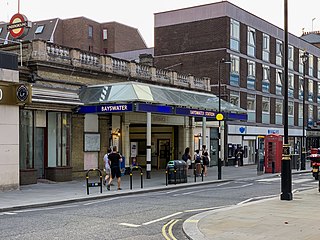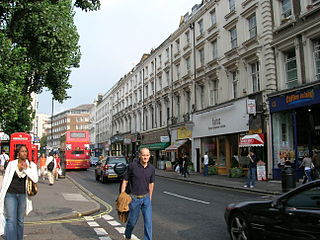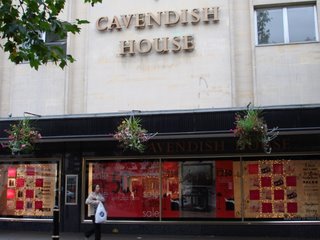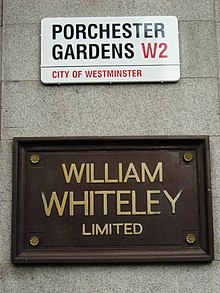
Bayswater is an area within the City of Westminster in West London. It is a built-up district with a population density of 17,500 per square kilometre. It is located 2.5 miles (4.0 km) west-northwest of Charing Cross, between Kensington Gardens to the south, Paddington to the north-east, and Notting Hill to the west.

Notting Hill is a district of West London, England, in the Royal Borough of Kensington and Chelsea. Notting Hill is known for being a cosmopolitan and multicultural neighbourhood, hosting the annual Notting Hill Carnival and Portobello Road Market. From around 1870, Notting Hill had an association with artists.

Bayswater is a London Underground station in the Bayswater area of the City of Westminster. The station is on the Circle and District lines, between Notting Hill Gate and Paddington stations and is in Travelcard Zone 1. It is less than 100 metres (330 ft) away from the Central line's Queensway station.

Westbourne Grove is a retail road running across Notting Hill, an area of west London. Its western end is in the Royal Borough of Kensington and Chelsea and its eastern end is in the City of Westminster; it runs from Kensington Park Road in the west to Queensway in the east, crossing over Portobello Road. It contains a mixture of independent and chain retailers, and has been termed both "fashionable" and "up-and-coming".

Queensway is a shopping street in Bayswater, an area of west London. It is home to Whiteleys, many restaurants, cafés, pubs, souvenir shops and a few high-street retail chains. Queensway and Westbourne Grove are identified in the London Plan as one of 35 major centres in Greater London. The street is numbered the B411 in the British road numbering scheme. Queensway is currently undergoing a major redevelopment on all sides, with a building on the top of the road being developed for £500m, Whiteleys for £1.2BN and a series of other redevelopments happening at the same time.

Douglas Rayner Hartree was an English mathematician and physicist most famous for the development of numerical analysis and its application to the Hartree–Fock equations of atomic physics and the construction of a differential analyser using Meccano.

Whiteleys was a shopping centre in Bayswater, London. It was built in the retail space of the former William Whiteley Limited department store, which opened in 1911 as one of London's first department stores, and was one of the main department stores, alongside Selfridge's, Liberty's and Harrods. The centre's main entrance was located on Queensway.

William Whiteley was an English entrepreneur of the late 19th and early 20th centuries. He was the founder of the William Whiteley Limited retail company whose eponymous department store became the Whiteleys shopping centre.

Cavendish House is Cheltenham's oldest and leading department store, located on The Promenade. Its establishment was of great significance for Cheltenham's future reputation as a leading shopping centre. Known as 'Cavendish House' from its early days, its name was officially adopted with the registration of a limited liability company in 1883. The store became part of the House of Fraser group in 1970.

Sir John Barker, 1st Baronet was a British entrepreneur of the late 19th and early 20th century. He was the founder of the Barkers department store in Kensington, London, United Kingdom.

John Lewis was an English philosopher and town councillor, known for being the founder of the John Lewis department store on Oxford Street, London and the national John Lewis department store chain.
United Drapery Stores, or UDS, was a British retail group that dominated the British high street from the 1950s to the early 1980s.
Sir Richard Burbidge, 1st Baronet was an English merchant.
H. Binns, Son & Co. was a chain of department stores based in Sunderland, later purchased and absorbed by House of Fraser.

Bourne & Hollingsworth was a large department store on the corner of Oxford Street and Berners Street. It was named after its founders, Walter William Bourne and Howard E Hollingsworth, brothers in law, who started the store in Westbourne Grove as a drapery store in 1894. The store then moved to the Oxford Street site (pictured) in 1902 due to competition with Whiteleys, and by 1928 the store had been remodelled in the Art Deco style.

Barkers of Kensington was a department store in Kensington High Street, Kensington, London. It began as a small drapery business, John Barker & Company, founded by John Barker and James Whitehead in 1870. Barkers grew rapidly to become one of London's largest and most well-known department stores. The company played a significant role in establishing Kensington High Street as one of London's principal shopping destinations for most of the twentieth century. The business was purchased by House of Fraser in 1957. Barkers closed permanently in 2006. Part of the former flagship building now contains a branch of Whole Foods Market (2019).
Pontings was a department store based in Kensington High Street, London and operated from 1863 to 1970.
Bobby & Co. was a provincial department store group based mainly in seaside towns on the south coast of England. The business operated from 1887 until 1972.
Benzie & Miller was a small department store chain based in Scotland and became part of House of Fraser in 1958.














